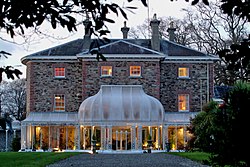
County Wexford is a county in Ireland. It is in the province of Leinster and is part of the Southern Region. Named after the town of Wexford, it was based on the historic Gaelic territory of Hy Kinsella, whose capital was Ferns. Wexford County Council is the local authority for the county. The population of the county was 163,527 at the 2022 census.
The Earl of Courtown, in the County of Wexford, is a title in the Peerage of Ireland. It was created on 12 April 1762 for James Stopford, 1st Baron Courtown. He had previously represented County Wexford and Fethard in the Irish House of Commons. Stopford had already been created Baron Courtown, of Courtown in the County of Wexford, on 19 September 1758, and was made Viscount Stopford at the same time he was given the earldom. These titles are also in the Peerage of Ireland. He was succeeded by his eldest son, the second Earl. He was a Tory politician and served under William Pitt the Younger as Treasurer of the Household from 1784 to 1793. On 7 June 1796, he was created Baron Saltersford, of Saltersford in the County Palatine of Chester, in the Peerage of Great Britain. This title gave him and his descendants an automatic seat in the House of Lords.

Gorey is a market town in north County Wexford, Ireland. It is bypassed by the main M11 Dublin to Wexford road. The town is also connected to the railway network along the same route. Local newspapers include the Gorey Guardian.
This is a list of people who have served as Lord-Lieutenant of Wexford.
Seán Redmond Etchingham was an Irish Sinn Féin politician.
County Wexford was a UK Parliament constituency in Ireland, which returned two Members of Parliament (MPs) to the United Kingdom House of Commons.

James Patrick Montagu Burgoyne Winthrop Stopford, 9th Earl of Courtown, styled Viscount Stopford between 1957 and 1975, is an Irish peer and politician. He is one of the 92 hereditary peers elected to remain in the House of Lords after the House of Lords Act 1999 and sits for the Conservatives.

James Stopford, 2nd Earl of Courtown KP, PC (Ire), known as Viscount Stopford from 1762 to 1770, was an Anglo-Irish peer and Tory politician who sat in the British House of Commons between 1774 and 1793.
James Thomas Stopford, 4th Earl of Courtown, known as Viscount Stopford from 1810 to 1835, was an Anglo-Irish peer and Tory Member of Parliament.
James Stopford, 1st Earl of Courtown was an Irish politician.

Tara Hill is an isolated hill and associated village near the Irish Sea coast in north County Wexford, Ireland. Though only 253 metres high, it dominates the landscape of northeast Wexford. It provides extensive views of the Wexford coast line, from Courtown harbour to Castletown.

1,000 Places to See Before You Die is a 2003 travel book by Patricia Schultz, published by Workman. A revised edition was published in November 2011. The new edition is in color. An iPad app debuted in December 2011.
The High Sheriff of Wexford was the British Crown's judicial representative in County Wexford, Ireland from the 16th century until 1922, when the office was abolished in the new Irish Free State and replaced by the office of Wexford County Sheriff. The sheriff had judicial, electoral, ceremonial and administrative functions and executed High Court Writs. In 1908, an Order in Council made the Lord-Lieutenant the Sovereign's prime representative in a county and reduced the High Sheriff's precedence. However, the sheriff retained his responsibilities for the preservation of law and order in the county. The usual procedure for appointing the sheriff from 1660 onwards was that three persons were nominated at the beginning of each year from the county and the Lord Lieutenant then appointed his choice as High Sheriff for the remainder of the year. Often the other nominees were appointed as under-sheriffs. Sometimes a sheriff did not fulfil his entire term through death or other event and another sheriff was then appointed for the remainder of the year. The dates given hereunder are the dates of appointment. All addresses are in County Wexford unless stated otherwise.
The Custos Rotulorum of County Wexford was the highest civil officer in County Wexford.
Abel Ram (1753–1830) was an Anglo-Irish landowner and politician. He was the son of Andrew Ram and Mary Digby, daughter of John Digby of County Kildare.
James Stopford was Bishop of Cloyne from 1753 until his death in Dublin on 23 August 1759: he had previously been Provost of Tuam, Archdeacon of Killaloe and Dean of Kilmacduagh.
La Réserve de Beaulieu & Spa is a five-star hotel and spa in Beaulieu-sur-Mer, France. It is a member of The Leading Hotels of the World. It was bought in 1997 by Nicole and Jean-Claude Delion. The Delions also own La Résidence de la Pinède hotel in Saint-Tropez.

Mary Stopford, Countess of Courtown, formerly Mary Powys, was the wife of James Stopford, 2nd Earl of Courtown.
Mary Stopford, Countess of Courtown, formerly Lady Mary Scott, was the wife of James Stopford, 3rd Earl of Courtown, and the mother of the 4th Earl.
Lady Marjorie Stopford was a Girl Guide leader, Duke of Edinburgh awards advisor, and volunteer for the Guide International Service (GIS), serving in post-civil-war Greece.









